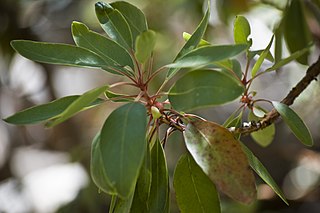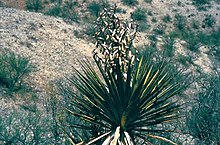
Dasylirion wheeleri is a species of flowering plant in the asparagus family (Asparagaceae), native to arid environments of northern Mexico and the southwestern United States.

Yucca × schottii is a plant species in the genus Yucca, native to southern Arizona, southwestern New Mexico, and the northern parts of Sonora and Chihuahua. The common names are Schott's yucca, hoary yucca, and mountain yucca. The "×" in the name indicates that this is a nothospecies, regarded as being a natural hybrid between two other species. In this case, Yucca × schottii is believed to have originated as a hybrid between Y. baccata and Y. madrensis. Yucca × schottii is firmly established and does reproduce freely in the wild.

Arbutus arizonica, commonly known as Arizona madrone, is a tree species in the heath family that is native to the southwestern United States and northwestern Mexico. Its range extends along the Sierra Madre Occidental cordillera from the Madrean Sky Islands of southeastern Arizona and southwestern New Mexico south as far as Jalisco. It has been found in Sonora, Chihuahua, Durango, and Sinaloa, with one isolated population in Tamaulipas.

Salix taxifolia, the yewleaf or yew-leaf willow, is a species of willow native to all of southern Mexico, also Pacific Coast regions, north to Sinaloa, and in the south Pacific Coast of Mexico into central Guatemala. Scattered populations are also reported from northern Mexico and from the US states of Texas, New Mexico, and Arizona.

The Pima Bajo people are indigenous people of Mexico who reside in a mountainous region along the line between the states of Chihuahua and Sonora in northern Mexico. They are related to the Pima and Tohono O’odham of Arizona and northern Sonora, speaking a similar but distinct language.

Agave shrevei is a member of the family Asparagaceae, indigenous to the Sierra Madre Occidental in Mexico, along the boundary between the states of Chihuahua and Sonora. Two subspecies are currently recognized, although a third has been proposed.

Hymenocallis pimana is a member of the genus Hymenocallis, in the family Amaryllidaceae. Common name in English is Pima spider-lily; in Spanish it is cebollín. It is endemic to a small mountainous region in the Sierra Madre Occidental, straddling the Mexican states of Chihuahua and Sonora. Many of the people of the region are of the indigenous group known as the Mountain Pima or Pima Bajo.

Yucca declinata is a species of the genus Yucca, family Asparagaceae. It is known only from the vicinity of Bacanora, in the Mexican state of Sonora. Botanist Howard Scott Gentry first collected the species and mentioned it in print, noting the differences between this population and the closely related species Y. grandiflora H. S. Gentry and Y. arizonica McKelvey. He did not, however, describe it as a new species. Later examination of his descriptions and his material led to the recognition of this as a new species.

Yucca madrensisH. S. Gentry is a plant in the genus Yucca in the family Asparagaceae. It is native to a mountainous region in the Sierra Madre Occidental in the Mexican states of Sonora and Chihuahua. It has also been reported from Arizona It grows on steep, rocky slopes in pine-oak forests.
Berberis pimana is a species of the genus Berberis in the family Berberidaceae. It is native to a mountainous region of the Sierra Madre Occidental in the Mexican states of Chihuahua and Sonora.
Pectis pimana is an herbaceous plant in the family Asteraceae. It is endemic to a mountainous area in the Sierra Madre Occidental, in the Mexican State of Chihuahua. Type locale is the village of Nabogame, 18 km northwest of Yepachic and about 10 km east of the state line with Sonora. Most of the inhabitants of Nabogame are of the indigenous ethnic group known as the Mountain Pima or Pima Bajo; the specific epithet "pimana" was chosen in their honor.
Lonicera cerviculata is a shrub in the genus Lonicera, family Caprifoliaceae, native to the Sierra Madre Occidental near the boundary between the Mexican states of Chihuahua and Sonora. It is a shrub up to 1.5 m tall with juicy, globose orange berries.

Passiflora bryonioides, the cupped passionflower, is a plant in the genus Passiflora, family Passifloraceae. It is native to northern Mexico and the south-western United States (Arizona).
Physalis caudella, the southwestern groundcherry or tomatillo chiquito, is a plant in the family Solanaceae, native to Arizona, Sonora and Chihuahua. The purple-green fruits are small but edible.
Ceanothus depressus Benth. is a shrub in the family Rhamnaceae, native to the Mexican states of Chihuahua and Sonora. It is a shrub up to 70 cm tall, growing in clearings in pine-oak forests.
Prunus gentryi is a species of wild cherry in the genus Prunus, family Rosaceae, native to the Mexican states of Chihuahua and Sonora. It grows along streambanks in mountainous regions of the Sierra Madre Occidental. The scientific description was published in 1937.

Dasylirion durangense, common name "sotol," is a perennial plant in the family Asparagaceae, native to Durango, Chihuahua and Sonora, Mexico. It is closely related to D. wheeleri S. Wats. and considered a variety of that species by some authors. The plant has a large basal rosette of long stiff leaves over 1 m in length, bearing sharp, curved spines along the margins. The flowering stalk can be up to 3 m tall, bearing small wind-pollinated flowers.
Prionosciadium saraviki, common name saraviki, is a plant species in the genus Prionosciadium, in the carrot family, Apiaceae. It is known only from a mountainous region of the Sierra Madre Occidental in the Mexican State of Chihuahua. Type locale is the village of Nabogame, approximately 18 km northwest of Yepachic, Chihuahua, 10 km east of the border with Sonora. The plant grows there mostly along creekbanks and near springs.

Yepáchic, sometimes spelled Yepáchi, is a community in the western part of the Mexican State of Chihuahua, approximately 10 km (6.2 mi) east of the boundary with the State of Sonora. It is located in the Municipio de Temósachic at an altitude of 1,780 meters (5,840 ft) in the Sierra Madre Occidental. Many of the people of the region are members of the indigenous ethnic group called Mountain Pima or the Pima Bajo. They are related to the Pima and Papago of Arizona and northern Sonora, speaking a similar but distinct language.
Joseph Edward Laferrière is an American botanist with a particular interest in ethnobotany.












